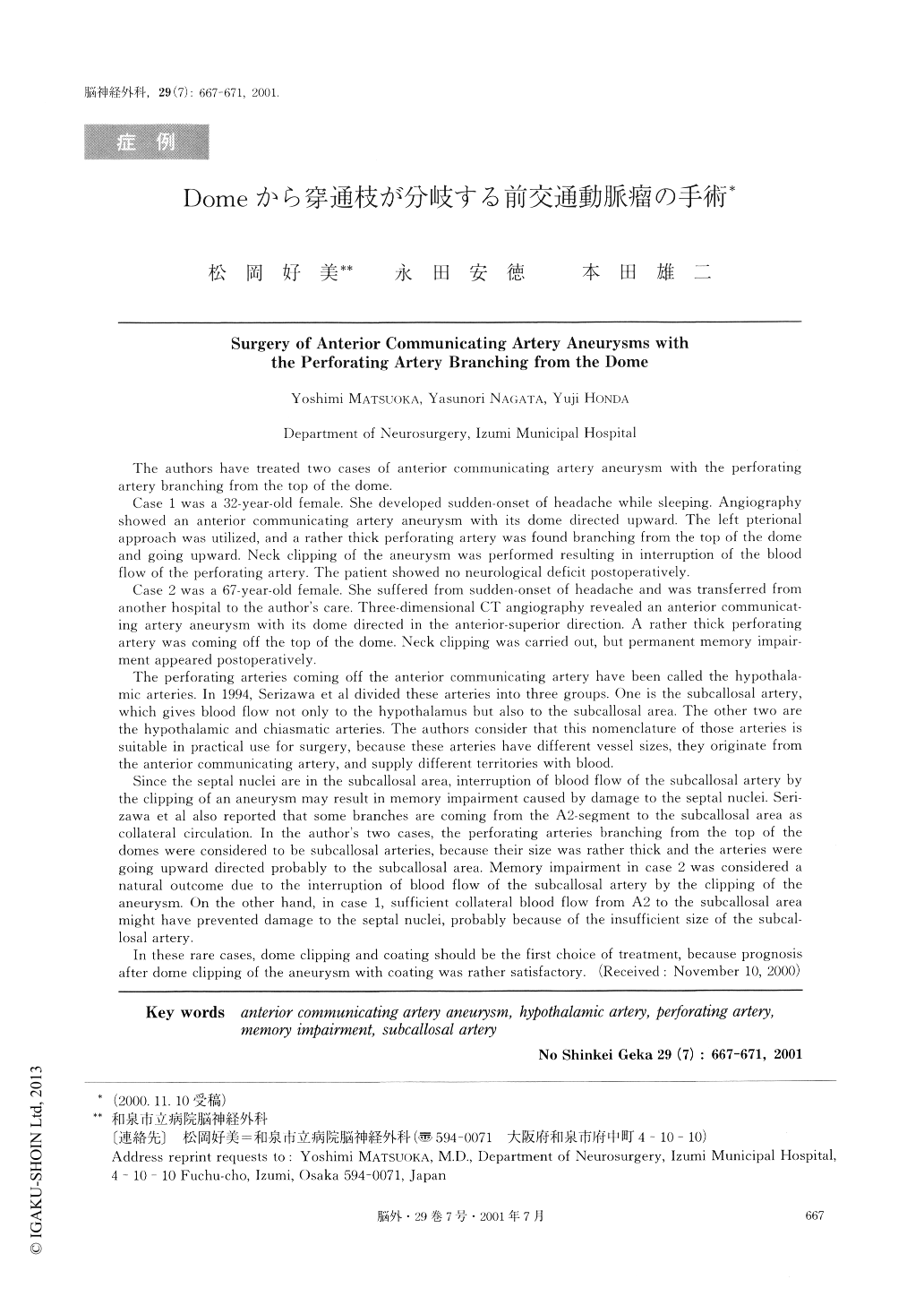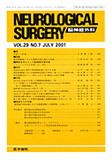Japanese
English
- 有料閲覧
- Abstract 文献概要
- 1ページ目 Look Inside
I.はじめに
前交通動脈瘤の術後に,記憶障害をみることがある(Tidswellら9)).その原因として,激しいくも膜下出血による脳のprimary damageや,再出血によるdamage,脳圧亢進などが考えられるが,手術による重要血管の損傷もその一因と思われる.
今回,われわれは,前交通動脈瘤の手術の際に,hypothalamic arteryがdomeの先端から分枝するためこれを温存することができず,動脈瘤のneck clippingを行ったところ,1例では記憶障害が出現し,1例では出現しなかった症例を経験したので報告する.
The authors have treated two cases of anterior communicating artery aneurysm with the perforatingartery branching from the top of the dome.
Case 1 was a 32-year-old female. She developed sudden-onset of headache while sleeping. Angiographyshowed an anterior communicating artery aneurysm with its dome directed upward. The left pterionalapproach was utilized, and a rather thick perforating artery was found branching from the top of the domeand going upward, Neck clipping of the aneurysm was performed resulting in interruption of the bloodflow of the perforating artery. The patient showed no neurological deficit postoperatively.
Case 2 was a 67-year-old female. She suffered from sudden-onset of headache and was transferred fromanother hospital to the author's care. Three-dimensional CT angiography revealed an anterior communicat-ing artery aneurysm with its dome directed in the anterior-superior direction. A rather thick perforatingartery was coming off the top of the dome. Neck clipping was carried out, but permanent memory impair-ment appeared postoperatively.
The perforating arteries comillg off the anterior communicating artery have been called the hypothala-mic arteries, In 1994, Serizawa et al divided these arteries into three groups. One is the subcallosal artery,which gives blood flow not only to the hypothalamus but also to the subcallosal area. The other two arethe hypothalamic and chiasmatic arteries, The authors consider that this nomenclature of those arteries issuitable in practical use for surgery, because these arteries have different vessel sizes, they originate fromthe anterior communicating artery, and supply different territories with blood.
Since the septal nuclei are in the subcallosal area, interruption of blood flow of the subcallosal artery bythe clipping of an aneurysm may result in memory impairment caused by damage to the septal nuclei. Seri-zawa et al also reported that some branches are coming from the A2-segment to the subcallosal area ascollateral circulation. In the author's two cases, the perforating arteries branching from the top of thedomes were considered to be subcallosal arteries, because their size was rather thick and the arteries weregoing upward directed probably to the subcallosal area. Memory impairment in case 2 was considered anatural outcome due to the interruption of blood flow of the subcallosal artery by the clipping of theaneurysm, On the other hand, in case 1, sufficient collateral blood flow from A2 to the subcallosal areamight have prevented damage to the septal nuclei, probably because of the insufficient size of the subcal-losal artery.
In these rare cases, dome clipping and coating should be the first choice of treatment, because prognosisafter dome clipping of the aneurysm with coating was rather satisfactory.

Copyright © 2001, Igaku-Shoin Ltd. All rights reserved.


